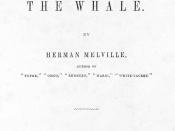Whitman often writes about the wondrous qualities of the human body in his poetry. This is especially evident in his poem "I Sing the Body Electric." He writes, "And if the body were not the soul, what is the soul?" (section 1). Always a central element in Whitman's work, the body is both an ostensible and central subject of many of his poems. Whitman strongly believes the body reflects the soul. Therefore, we can deduce that physical markings, which decorate the body, also reflect the soul.
Melville and Hawthorne also recognize the importance of the human body. However, instead of focusing on the beauty that Whitman sees, they focus on deformities and other unwanted physical markings of the body. They use these indications throughout their works as devices to uncover and explain the inner being, or the soul, of a character. The markings are permanent structures the characters are born with (instated by nature), or are gained during their lifetime (purposefully instated by man or beast).
Melville and Hawthorne both choose to take a uniqueness of the body and use it to distinguish their characters. Moby Dick, The Scarlet Letter, and "The Birthmark" all use distinct physical markings on key characters to make them easily identifiable, individualistic, and to demonstrate characteristics of their soul. The marks' symbolism is perceived in various ways by the communities and by the possessors. These views are dynamic and are altered over time due to characters and communities being able to look beyond what they perceive the mark to symbolize, to the true soul that is portrayed by the mark.
Physical markings can have a number of difference sources or causes. Whitman generally discusses the natural beauty, wonder, and awe of the body. The symbols are often inborn markings placed there by nature or a...


